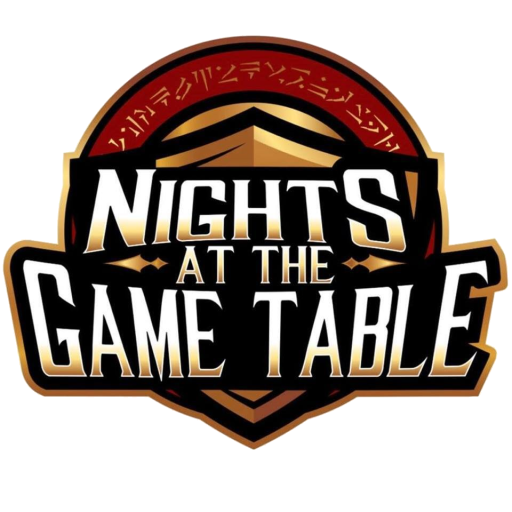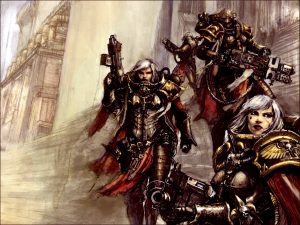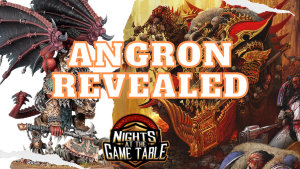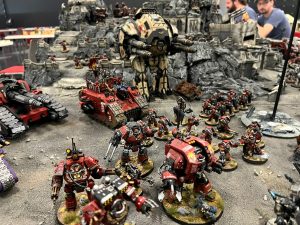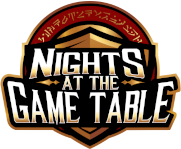Last week we started our current mini-series, wherein we are looking at playing into our opponents’ weaknesses in their preferred play-style. To begin, if you haven’t already, read back to the first article in this series, where we broke down the four play-styles and some of their characteristics.

In this series, we look at some on the board strategies to counter various play-styles. This week we’re going to look at the Aggressive-Tight Tank-Commander, how to identify them, counter their strengths, and exploit their weaknesses.

Identifying a Tank Commander:
As we covered previously, a Tank Commander is a player who favors an aggressive-tight style. The elements of a play-style can be sometimes correlated to a person’s personality outside the game, so we can look for some indicators before the models even hit the table that our opponent may lean toward the Tank Commander play-style.
Identifying our opponent’s tendencies early is helpful not only because it gives us more time to implement our counter stratagems, but it also can help us identify early on when someone may be trying to play counter to their natural playstyle and may be more prone to going “on tilt,” playing their reactive loose list tightly and aggressively when put under pressure.
We also want to assess the playstyle that best fits our opponent’s list and if there seems to be a discrepancy between that and their natural playstyle, we may be able to gain an advantage by pushing the scenario on the table to skew further away from either their own natural playstyle or the most efficient playstyle for the list. That is, a Tank-Commander who is running a more Changeling-style list may begin protecting their chaff units and concentrate on setting traps to protect them rather than achieving in-game mission objectives.
Let us start our identification of a Tank-Commander by looking at some potential personality traits:
- Loud, direct personality: this player is more likely to be chatty and look to start, maintain, and direct outside-the-game banter.
- Boastful: this player may take the first opportunity to brag about previous wins and successes.
- Organized: this player is more likely to be organized in their pregame setup; there is a system to where their gaming tools and models are placed, either on trays or in the bag.
Basically, we’re looking for someone who displays elements of a tight approach by demonstrating planning or organization, combined with elements of an aggressive personality by leading or dominating conversation and generally making their presence apparent.
Obviously, these traits aren’t exclusive or required for someone to lean toward a Tank-commander playstyle, simply indicators. When identifying an opponent’s playstyle and approach, it’s important to be regularly reevaluating and reassessing. A wily opponent can be aware of these very same categorizations and actively misrepresent themselves in order to give their opponents the wrong read.

Countering Tank-Commander Plays:
The Tank-commander play-style is built on a desire to dictate the action and force the issue on the table with a coordinated plan of attack. It is a calculated play-style and wants to be hitting checkpoints and executing steps of a plan that put the opponent on the back foot until they either back off the table entirely or are destroyed.
On the table, we can implement a few strategies to counter or exploit this play-style’s aggression and tightness through careful placement or play around objectives, setting obvious traps, being unpredictable, and being overly aggressive or overly defensive.
As we all know, objective placement or positioning around objectives is crucial to winning the game. Knowing a Tank-commander’s tendency toward aggression, we can use the positioning of objectives or our positioning around objectives to counter this aggression and use it against them to win the mission. However, as a tight player a Tank-commander is unlikely to blindly get themselves out of position.
If our opposing Tank-commander list features predominantly short-ranged threats, spreading objectives into corners and edges of the board can allow us to funnel the action into one part of the board and away from most of the objectives. Even in preset objective missions, we can usually still direct their aggression away from the majority of objectives by presenting juicy targets and a path for his main hitters to take that lead them away from the middle of the board into positions from which they will only be able to threaten one or two objectives in the late game.
If our opponent has a list more focused on ranged aggression, this task is a little more difficult, but essentially the same; we can try to use terrain to position our high value targets in places where our opponent must place their own shooting units away from objectives in order to draw line of sight.
If objectives are placed after sides are determined, we can look to put objectives opposite of where the opponent wants to be. That is, if their aggression is primarily combat based, placing objectives in their backfield can force a defensive posture. On the other hand, if their aggression is more based on shooting, forcing them to come across the board or into positions with poor firing lanes will force a choice between game objectives and aggression.
Another way of countering a Tank-commander and their aggressive plays is to set blatantly obvious traps. For example, we can place throwaway bait units in range for our opponent to attack in their next turn, but then then position the rest of our forces to collapse on that spot in our next turn, but out of range for the upcoming turn.
The Tank-commander is then presented with the choice of just taking the bait and hoping to endure the counter-attack or holding back and, as a result, not executing any degree of aggression in their upcoming turn. While against a Warboss-style we would want to put our bait in unimportant areas of the table, against a more careful Tank-commander we want to further enhance the trap by positioning our bait units in tactically valuable locations. As a result, the tight playing Tank-commander is more tempted to take the bait, and if they do not we gain the position advantage.

We can also counter a Tank-commander’s tight-aggression by overwhelming aggression of our own. Specifically we can use a portion of our army to push forward quickly and into their half of the board, if not their deployment zone. The goal with this move is to force the Tank-commander to stay at home and deal with this threat, or abandon their position entirely and cede their territory.
Finally, rather than strictly countering their playstyle, we can look to throw off a Tank-commander from their gameplan by being unpredictable. Obviously this will be easier said than done, but setting up and positioning to telegraph an attack and then not making it can throw off our opponent’s plans and leave them a step behind. They will be then forced to abandon their planned counter and adjust to a flowing game state.
For example, if early on we exhibit combat based aggression and pushed forward nearly recklessly, the Tank Commander is likely to lay a trap of some sort, and may opt to sacrifice board position to set the trap, expecting to be able to close the trap and regain the board control. If we then pull back away from the trap and simply take control of the given up portion of the board, we not only take a strong position in the game, but force a planning player to ditch their plan and come up with a new approach.
So there we have some high-level tactics to employ to counter a tightly aggressive Tank-commander opponent. The earlier we can get a read on this being their playstyle, the sooner we can implement these strategies to take advantage of their tendencies and exploit their weaknesses. Next week we will look at how to approach and gain advantage over an opponent with a more reactive playstyle. Thanks for reading, and let us know what you think in the comments below.
